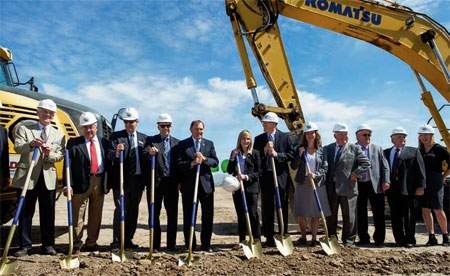A new facility in North Salt Lake will convert food waste into natural gas and fertilizer, creating what Gov. Gary Herbert said is a “win-win” for cutting waste and methane emissions at landfills while powering communities.
Construction began last week on the $43 million facility called an anaerobic digester, which will liquefy food scraps and use water, heat and bacteria to turn them into methane gas and fertilizer.
The facility, called Wasatch Resource Recovery, will consume up to 360 tons of solid waste daily that would otherwise rot in landfills, emitting methane, a greenhouse gas, into the atmosphere. Instead, the facility will capture that gas and use it as an energy source. Officials estimate that it will cut emissions in an amount equivalent to 75,000 fewer cars driving each year.
“It is win-win-win all the way around,” Herbert said at a groundbreaking ceremony at the site recently.
{mprestriction ids="1,3"}Morgan Bowerman, sustainability manager for Wasatch Resource Recovery, said that the facility can handle material that most composters cannot, such as bones, dairy, oil or sugar. “We can take all of that,” she said. Bowerman said several grocery store chains, restaurants and other companies have agreed to send their food waste to the North Salt Lake facility.
“This facility is the first of its kind in Utah,” said Bowerman. “Organic waste makes up nearly 30 percent of our landfills. Our process can use that waste and result in considerable cost savings for businesses, institutions and service providers.”
Special equipment removes contaminants and then grinds and liquefies the material to create a slurry suitable for the digester. The digester breaks down the food and converts it into methane, which is collected and is then produced into pipeline-grade natural gas.
“This process can generate enough natural gas from previously landfilled materials to continuously supply a community the size of Bountiful,” said Bowerman. “The solids from the digestion produces a bio-based, nutrient-rich fertilizer which can then be marketed to the agriculture industry.”
“By forging unprecedented partnerships, Utah continues to lead on providing innovative, market-based solutions that drive our energy economy, grow jobs, and improve our air quality,” said Laura Nelson, energy advisor to Herbert and the executive director of the Governor’s Office of Energy Development. “We are proud to carry forward Gov. Herbert’s vision to help create pioneering outcomes to meet the demands of our future through enterprising projects, like Wasatch Resource Recovery.”
BP Energy Corp. has agreed to purchase natural gas created by the facility, according to The Salt Lake Tribune.
Wasatch Resource Recovery is a partnership between bioenergy company ALPRO Energy and Water and the South Davis Sewer District. The facility is expected to be running in fall 2018.{/mprestriction}








